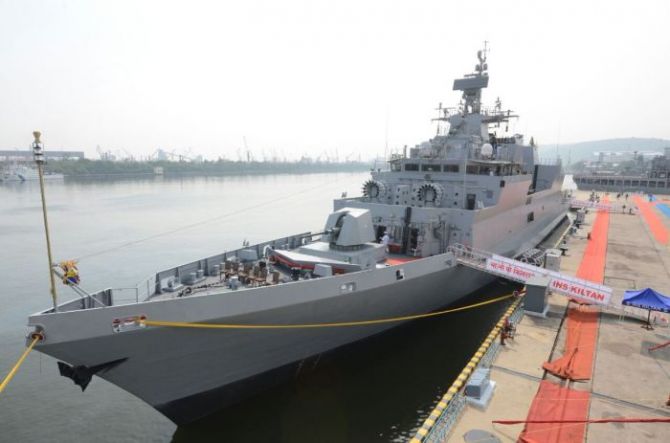'An ASW corvette without towed array sonar and an ASW helicopter is nothing more than a feeble joke,' says a retired navy commodore.
Ajai Shukla reports.

Like numerous Indian warships before it, the navy's newest anti-submarine warfare (ASW) corvette, the INS Kiltan, joined the fleet on Monday, October 16, 2017, without equipment crucial for discharging its primary role -- detecting and destroying enemy submarines.
The Kiltan -- like two predecessor ASW corvettes, the INS Kamort and the INS Kadmatt -- was commissioned by Defence Minister Nirmala Sitharaman in Visakhapatnam without 'advanced towed array sonar' (ATAS), essential for detecting enemy submarines in the shallow Arabian Sea where the peculiar temperature and salinity gradients sharply limit the effectiveness of conventional sonars.
Without ATAS, enemy submarines can sneak undetected to within 50 to 80 kilometres of Indian warships and destroy them with heavy torpedoes from standoff ranges.
The Kiltan will also make do without another vital ASW platform -- a naval multi-role helicopter (NMRH), which flies low over the sea, lowering 'dunking sonar' into the water listening for audio signals from enemy submarines.
The navy is left with just a handful of NMRH choppers -- 12 Sea Kings, of which no more than six are usually operational at any time; and eight Kamov-28, of which 4 to 6 are available.
The navy must distribute these 10-12 helicopters between some 35 capital warships.
"An ASW corvette without towed array sonar and an ASW helicopter is nothing more than a feeble joke," says a retired navy commodore with decades of ASW experience.
Yet, neither of the two Indian warships that called on the Japanese port of Sasebo last week -- the frigate INS Satpura and the ASW corvette, the INS Kadmatt -- has towed array sonar.
While passing through the South China Sea, these warships would have been at the mercy of Chinese submarines.
In June, the defence ministry scrapped an NMRH purchase that had been initiated in 2009 and was at the point of conclusion.
Instead, returning to the start line, the navy has now re-initiated fresh procurement for 123 NMRH.
After this correspondent reported that every Indian warship built after 1997 lacked towed array sonar on May 16, 2014, the defence ministry contracted six ATAS systems from the German naval systems giant, Atlas Elektronik, for just under euro 40 million (Rs 306 crore/Rs 3.06 billion).
Those six ATAS systems were earmarked for the navy's three Talwar-class frigates (INS Talwar, INS Trishul, INS Tabar) and three Delhi-class destroyers (INS Delhi, INS Mumbai, INS Mysore).
In effect, a Rs 50 crore (Rs 500 million) ATAS multiplied the survival chances of warships worth several thousand crores apiece, each crewed by hundreds of sailors.
Yet, the National Democratic Alliance government has gone slow on a follow on proposal to build 10 more ATAS systems at the Bharat Electronics Ltd, in partnership with Atlas Elektronik.
Those 10 systems are intended for three Shivalik-class frigates (INS Shivalik, INS Satpura, INS Sahyadri); three Project 15A destroyers (INS Kolkata, INS Kochi, INS Chennai) and four Project 28 ASW corvettes, the third of which was commissioned on Monday.

Without ATAS, India's frontline capital warships, including the aircraft carrier, INS Vikramaditya, rely on a relatively ineffective Passive Towed Array Sonar (PTAS), and an indigenous hull-mounted sonar called HUMSA to detect enemy submarines.
Perhaps oblivious to all this, Sitharaman stated while commissioning the Kiltan that: 'The government fully appreciates the nation's defence requirements and requisite finances would be made available for the modernisation and development plans of the navy', according to a defence ministry release.
The INS Kiltan's keel was laid at the Garden Reach Shipbuilders & Engineers, Kolkata in August 2010 and she was launched in March 2013.
She has been undergoing sea trials since May and has taken more than seven years in construction.
The corvette, manned by 13 officers and 178 sailors, is propelled by a combination of four Wartsila diesel engines to achieve a cruising speed of 25 knots. She has an endurance of 3,500 nautical miles.
In a significant departure from her predecessors, the INS Kamorta and the INS Kadmatt, the INS Kiltan is India's first major warship with an all-composite superstructure.
This has made the vessel lighter by about 100 tonnes.
Her weapons package includes heavy weight torpedoes, ASW rockets, an Otomelara 76 millimetre anti-aircraft gun and two multi-barrel 30 mm AK-630 guns for close-in protection against enemy aircraft.
The corvette, in naval tradition, inherits her name from a previous INS Kiltan (numbered P 79), a Soviet-supplied Petya-class ASW vessel that served in the fleet for 18 years before she was decommissioned in June 1987.
The four Project 28 corvettes are all named after coral islands in the Lakshadweep archipelago in the Arabian Sea.










